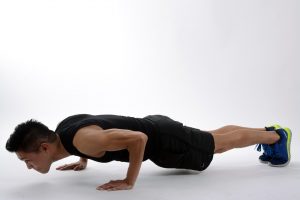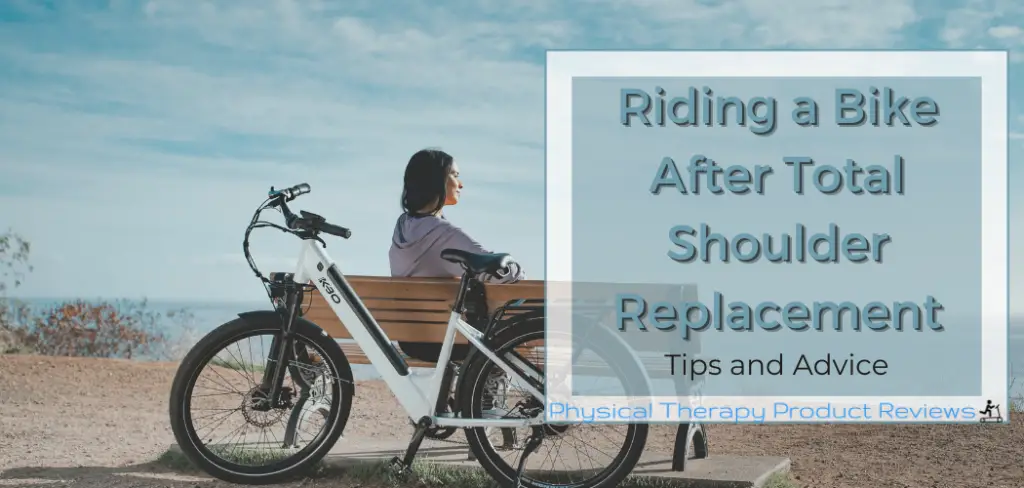If you have had a total shoulder replacement, riding a bike is something you won’t be able to do right away. However, riding a bike has many benefits, including improved cardiovascular health, decreased risk of obesity, and mental health benefits.
If you’ve always been an avid bike rider, you might have some questions about riding after a total shoulder replacement, including:
- When is it safe to return to biking?
- What do you need to do to get back to biking faster?
- How do you keep your surgical shoulder safe?
This article will review the steps needed for riding after surgery, what to expect during rehabilitation, and how long it takes to heal from riding a bike post-op.
More About Total Shoulder Replacement Surgery
A total shoulder replacement is a surgical procedure in which the ball and socket joint of your shoulder is repaired or replaced using an artificial part. The surgery is often the last resort to relieve pain from rotator cuff disease, rheumatoid and Osteoarthritis, and other chronic conditions.
 The surgery starts by making an incision on the front of your shoulder and then goes into the joint to remove damaged bone or cartilage.
The surgery starts by making an incision on the front of your shoulder and then goes into the joint to remove damaged bone or cartilage.
The new parts are inserted in place, which can be made from metal alloys like titanium alloy, stainless steel, or cobalt-chromium; a plastic material called polyethylene terephthalate (PET); or something known as a “hybrid” of biological tissue and implant.
The surgery typically takes about two hours to complete, but the recovery time can vary from person to person. For some people, it takes 6-weeks before they can lift their arm above shoulder height again or some up to 6 months.
Riding a Bike After a Total Shoulder Replacement
 One of the best parts about a total shoulder replacement is that you get to get back on a bike sooner than most other surgeries.
One of the best parts about a total shoulder replacement is that you get to get back on a bike sooner than most other surgeries.
You can begin to ride a stationary bike as soon as 2-weeks post-surgery, as long as you wear your surgical sling and protect the shoulder while you do it. No resting the arms on the handlebars yet.
After 6 weeks from surgery, you typically start to gradually put weight through the arms without wearing the sling. We typically let people ride the stationary bike without holding on to the handlebars at this time and try to build up a tolerance.
At 8-10 weeks, you can ride a bike on paved and concrete paths with minimal obstacles to avoid. Pay attention to pain in the shoulder and swelling, as you might not be able to ride as long as you want before pain sets in.
At 12 weeks from surgery, feel free to get back to normal road cycling, but certain positions such as the arrow position might not be comfortable just yet. You will also have to limit how long you are riding your bike time as use
Finally, 6-months after surgery, you can try and return to single-track mountain biking. At this point, the shoulder is pretty solid, the soft tissue has healed, and the shoulder can handle the demands of a variable trail system.
How To Tell If You Are Ready To Return to Cycling After a Shoulder Replacement
There are a few ways that you can test to know if you are ready to return to cycling after surgery.
The first way to test is if you can perform a full plank position. If you can hold a plank either on your knees or with the knees fully extended for 5 x 20-second bouts without increasing pain or swelling, then your shoulder is ready for road cycling.
The second way to test is to see if you can do a full push-up. Get into a full plank position and see if you can do 5 push-ups; even mini push-ups count. If you can do this test, then you can return to singletrack mountain biking after surgery.
What Exercises Help You Prepare for Riding a Bike After a Shoulder Replacement
 It’s essential to do exercises that strengthen the rotator cuff, deltoids, and scapular muscles. These include:
It’s essential to do exercises that strengthen the rotator cuff, deltoids, and scapular muscles. These include:
- Shoulder external rotation with dumbbells
- Push-ups
- Bench press or chest flies (both done on a table)
- Overhead tricep extension with a resistance band or cable attachment
You can also do:
- straight arm pull down with resistance bands or cable attachment
- seated row on a table (elbows are bent 90 degrees)
FAQ About Riding a Bike AFter a Total Shoulder Replacement
Can you Ride a Bike with a Shoulder Sling on?
Yes, you can ride a stationary bike with a shoulder sling on, but you should not ride a bike that is not stationary with a shoulder sling on. This could be a disaster if you were to crash.
What Shoulder Supports Can I Wear While Riding a Bike?
If you begin to ride a bike and have some shoulder discomfort, you can wear a shoulder compression sleeve. The shoulder compression braces help by providing extra support and decrease muscle tightness.
If that seems too bulky, you can also try using kinesiotape to help with that support. To see how you can try kinesiotaping your shoulder, look at this video.
Can Riding a Bike Damage a Total Shoulder Replacement?
This is unlikely unless you crash the bike.
Some people like to wear a brace or support over the surgical site to prevent riding-induced pain and swelling, but it’s not necessary if you are riding on paved surfaces with minimal obstacles.
Even quick adjustments on the bike won’t damage the new shoulder joint. It may irritate the muscles for a day or two, but should not be a lasting pain.
How Long Can You Ride A Bike After Surgery?
You can ride for as long as you want, increasing in 5 minutes increments each week, as soon as you can put weight through the arm.
Start on easy paved trails at 10-15 minutes to see how the arm feels. Then a gradual progression on easy trails to 30-45 minutes with 5 minutes increments each week will help the body adust and prevent an overuse injury.
Once you can ride 45 minutes on concrete and paved paths, you can start to venture off-road to gravel and easy singletrack.
What Type of Bike Should I Ride After a Total Shoulder Replacement?
You can ride any bike after surgery that has handlebars, but riding with flat bars is more comfortable and prevents pressure on the surgical incision site while riding. Post-surgical pain may limit riding time and distance.
We recommend starting with a cruiser bike that is more upright and puts less pressure on the repaired shoulder joint.
You can then gradually progress to a road bike or a mountain bike to lean on the handlebars more.
If you are having shoulder pain transitioning to a mountain bike, make sure that the angle is around 90 degrees with your shoulder and your torso.
What Bike Adjustments do you Need to Make After a Shoulder Replacement?
 If you are riding a mountain bike, make sure that your torso/shoulder angle is around 90 degrees. This is also the optimal position for riding before surgery.
If you are riding a mountain bike, make sure that your torso/shoulder angle is around 90 degrees. This is also the optimal position for riding before surgery.
You may have to move the seat forward or backward to achieve this arm position.
You can also use a shorter stem to make the handlebars closer to your body and to decrease the reach needed in the shoulders.
What to do if your Shoulder Hurts Riding a Bike After a Shoulder Replacement?
The best thing to do is to stop biking and try to determine why the shoulder is hurting.
First, try and relax on the bike. If you tighten muscles in the shoulders and consistently squeezing muscles while you are riding, this can cause pain.
Second, check your posture on the bike and make adjustments to get to that 90 degrees angle.
Finally, if you are still having shoulder pain, it could be a strengthening issue, and you need to continue with your PT exercises to get the shoulders stronger.
Conclusion:
Riding a bike after shoulder surgery should be safe and simple.
The most important thing to do is listen to your body when riding the bike for the first time post-surgery. You want to monitor how you are feeling so that if you feel pain, then it’s okay to stop riding or adjust something on the bike.
In the event of pain, stop riding and speak to your physical therapist.
The best advice is to take it easy first and gradually increase riding time as you feel better each week.
Other Great Rehab Related Articles
GLP Weight Loss and Back Health: Effective Strategies and Insights
How to Stay Active After Cervical Fractures: Expert Tips and Advice
Dealing with Painful Stairs After Ankle Replacement Surgery
Walking After a Total Ankle Replacement: Tips for a Successful Recovery
Exercises While Non-Weight Bearing After Ankle Replacement: Elevation, AROM, Leg Raises, and More
Ankle Pain with Stairs: Causes and Home Treatment Options
Disclaimer: The information provided in this post is for educational purposes only. This is not a substitute for a medical appointment. Please refer to your physician before starting any exercise program.






